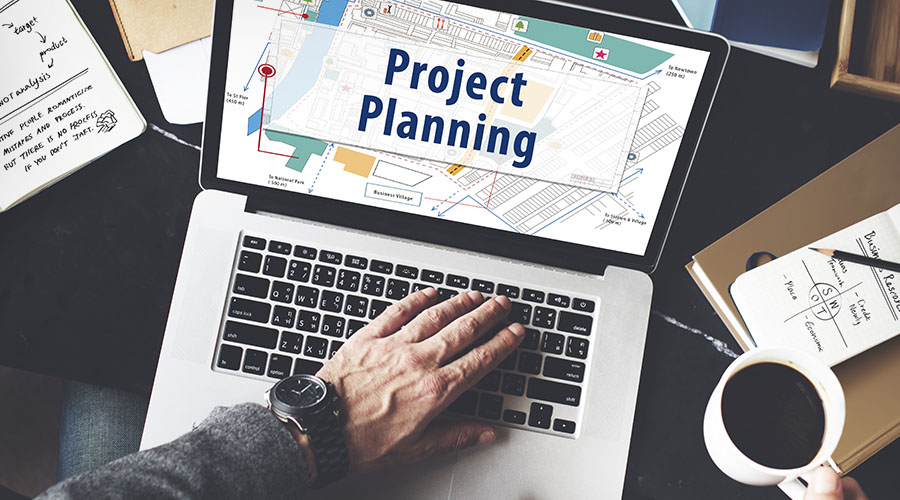What if you didn’t understand one of the fundamental skills you need to succeed in your career?
The longer you go in your career, the more likely you are to be responsible for a number of different projects. The success or failure of these projects may mean the difference between receiving a promotion and getting shown the door.
No project can be successful, though, without a project plan. And that means it’s important for any ambitious worker to understand how to create a project plan.
Ready to get started? Keep reading to learn everything you need to know about how to create a project management plan, plus how you can get certified in this exciting field.
What Is Project Planning?
Project planning involves defining the project scope, identifying your key objectives, and devising concrete steps to achieve those goals. Generally speaking, the more detailed the plan is, the more successful the project is likely to be.
Typically, such plans are devised by executives and other key decision-makers within an organization in conjunction with managers and other team leaders. Together, they help generate a management plan that helps everyone achieve the various goals outlined by the project planning process.
Also Read: 5 Essential Project Management Steps You Need to Know
Begin With Research and Preplanning
The first step in creating any project plan is, obviously, planning. Specifically, you’ll need to conduct extensive research and take certain preplanning steps before the project can move any further.
For example, research may involve learning more about the problems the project intends to solve. By understanding how extensive an existing issue is, you can learn more about how ambitious your project will need to be. However, you must balance everything that you and the team would ultimately like to accomplish with your existing resources, chiefly money and time.
Define Project Scope, Budget, and Timeline
Once you have a better idea of how extensive the existing issues are and how many different ways you could improve them, you can develop the full scope of the project. To do this, you may need to research resources, like notes from your top sales members, minutes from previous team meetings, requests for proposals (RFPs), and other important internal documents.
Another major consideration when learning how to create a project plan is the timeline of the project. There may be cases where you can afford to take your time, but it’s not uncommon that you’ll need to complete your project according to pre-ordained deadlines. For example, a project devoted to learning more about your core demographics would need to be completed well ahead of the holiday sales rush.
Once you have a firm deadline in place for project completion, you can more accurately define the scope and budget for the project. And don’t forget that you’ll need to create an entire project timeline — not just a deadline — to meet important milestones along the project’s progress.
Project Plan vs. Work Breakdown Structure
One of the key reasons you need to learn how to create a timeline for a project with milestones is that any successful project needs a work breakdown structure. And in order to develop that, you must first understand the difference between a traditional project plan and a work breakdown.
Think of the project plan as the “big picture” — which is why any future leader needs to know how to make a project plan. This overview helps outline all the major goals of the project, while the work breakdown is designed to create a game plan that helps make the vision of that big picture a reality.
For example, the breakdown turns every goal into a specific set of deliverables and sub-deliverables that help keep each employee on task. Additionally, these breakdowns are represented in a visual structure. In addition to helping you reach the visual learners in your organization, such a visual breakdown helps everyone ensure they are on the right track with a single glance, which is key for productivity.
Also Read: Project Management Frameworks and Methodologies Explained
How to Make a Project Plan: Plan Out Your Resources
Want to know what separates a successful project manager from a failed one? It all comes down to how well you can manage the resources available to you.
The most obvious resources that we have already touched on are, of course, money and time. How long you have to complete a project and how many financial resources you can devote to it will have a major impact on the success or failure of the entire project.
Other resources include:
- The technology available to you versus what isn’t
- Physical resources, which can include specific office space and physical assets you may need to acquire for the project
- Your team
This final resource is perhaps your most valuable one, as each team member brings certain talents to the table. That’s why it’s vitally important to have a diverse team — because they provide diverse skills.
Once you have a better idea of what your various resources are, you should place all the information in a digital dashboard. This will make it easier for team leaders to allocate resources to different needs while keeping everyone on the same page.
Run Your Final Plan by Your Internal Team
You’re probably familiar with the old phrase: “It takes a village to raise a child.” And in the workplace, sometimes it takes a village to develop a project plan. With this in mind, your final step when drafting the initial plan is to run it by your internal team.
Why would you review things with the team rather than take it straight to the stakeholders? The most basic reason is that your team will have a better idea than you about how viable various milestone dates are. They may also have further suggestions about how doable some of your assignments in the project are in real-world terms.
What should you discuss with your team regarding the project plan? Review the various deadlines, milestones, meeting dates, recent changes, and dependencies. It’s also important to alert the team to any assumptions you have been working under while planning. Nobody likes to imagine the worst-case possibility, but there is always a chance your assumptions are wrong. Discussing the details with your team can help identify major changes required to the project plan before you deliver it to your stakeholders — potentially saving you from embarrassment or a canceled project.
Why Are Project Plans Important?
The primary reason project plans are so important is simple: Without a good plan in place, any given project will be, at best, barely controlled chaos.
For example, without knowing how to create a project plan, different teams might be working on the same parts of the project without realizing it, and working at cross-purposes will likely keep everyone from meeting important milestones. At best, everyone will be frustrated by a lack of planning and coordination, and this will lead to disruptions in productivity and quite possibly drive your most valuable workers away.
That’s the bad news. The good news is that the opposite holds true as well. A good plan can keep everyone coordinated and motivated toward completing their individual responsibilities. And collectively, this helps make your entire organization more competitive than it was before.
Also Read: What is a WBS in Project Management, and How Do You Use it?
How to Manage Your Project Plan
It takes a lot of time and effort to master how to create a project plan. But make no mistake: once you have such a plan in place, it also takes a lot of time and effort to properly manage it.
Why do you need to actively manage your project plan? When you first sit down to create the plan, you are working with certain variables that will most definitely change over time. These variables include aspects like the project schedule that are constantly changing. Don’t worry, though, because other details should remain stable for the duration, including your cost management processes and procurement plans.
In other words, you need to stay on top of the variables over time. And as the variables change, you need to make sure your project plan changes accordingly.
Execute Your Plan and Adjust as Needed
Once you have a plan in place, executing it is as simple as pressing play on a device. Let various team leaders know the parts of the plan that concern them, including milestone dates and the overall deadline. Then trust them to play their parts to the best of their abilities. If all goes according to plan, the project will largely take care of itself, thanks to your diligent planning and your hardworking team.
If and when you need to make adjustments to the plan, do so using special visualization software that your entire team can follow. For example, ProjectManager can help you adjust project goals and assign project tasks, and Gantt can help you make visual adjustments to the plan. With the help of the right software, you can make adjustments to the plan and changes to assignments at the touch of a button.
Master Creating Project Plans Today
Now you know how you and your project team can create, execute, manage, and adjust a solid project plan. But do you know how to take your skills in project planning to the next level?
Master all the skills you need quickly by completing this comprehensive online project management certification delivered by Simplilearn, in collaboration with the University of Massachusetts. This six-month post graduate program provides you with live classes, experience working on real-world, industry-based projects with the top project management tools and best practices, and hands-on capstone projects to showcase the skill set you have gained.
Just as every good project starts with a plan, every good leader starts with the right education. Get the training and certification you need today to become the successful leader of tomorrow.
You might also like to read:
What’s a Requirements Traceability Matrix (RTM), and How Do You Create It?
13 Key Project Management Principles and How to Use Them
Project Management Phases: A Full Breakdown
How to Become a Project Manager? Here’s Everything You Should Know







